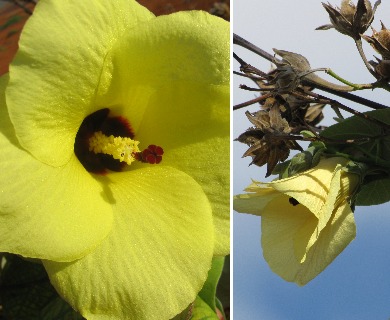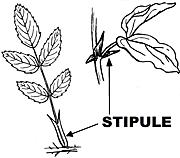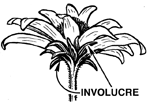Hau
Hibiscus tiliaceus
Mallow family (Malvaceae)
Native species (indigenous)
This common small tree of lowlands, especially shores, through the islands, is characterized by large funnel-shaped bright yellow flowers 3–3 1⁄2 inches (7.5–8 ) long and broad, usually with dark red “eye spot” inside, and by long-stalked heart-shaped and nearly round leaves with mostly seven or nine main veins from base, whitish gray hairy beneath.

©2010 Forest And Kim Starr
Leaves with leaf-stalks of 2–5 inches (5–13 ) and with two large short-pointed whitish hairy () 1–1 1⁄2 inches (2.5–4 ) long, shedding early and leaving a ring scar. Blades 4–7 inches (10–18 ) long and broad, sometimes larger, abruptly short- or long-pointed at and heart-shaped at base, rarely wavy on edges, slightly thickened and leathery, shiny yellow green and hairless on upper surface, lower surface with three narrow near base of main veins.
Flower clusters () at or near ends of twigs, branching. Flowers are many, few in each cluster, each with whitish hairy stalk of 3⁄4–2 inches (2–5 ) and gray green hairy cup () 3⁄4 inch (2 ) long usually with 9–10 narrow pointed 1–1 1⁄4 inches (2.5–3 ) long, gray green hairy, tubular with five narrow long-pointed Petals five, yellow, usually with dark red spot at base inside, 2 1⁄2–3 1⁄2 inches (6–9 ) long, rounded but broader on one side, with tiny star-shaped hairs on outer surface, united at base. numerous on column about 2 inches (5 ) long united with at base. has densely hairy conical five-celled long slender and five broad stigmas. Flowers opening and closing the same day, the petals withering and turning to orange and later to red.
Seed capsules are elliptical, 1–1 1⁄4 inches (2.5–3 ) long, long-pointed, gray green hairy, splitting into five parts and breaking open the and which remains attached. Seeds, three from each cell, brownish black, 1⁄8–3⁄16 inch (3–5 ) long, hairless. Flowering and fruiting probably through the year.
Sapwood is whitish and heartwood dark greenish brown. Wood moderately soft and porous, and moderately heavy ( gr. 0.6). It has been used sparingly by Hawaii’s craftwood industry for carved and turned bowls and bracelets. The wood so used is mostly sapwood, so that the mottled dark heartwood inclusions give a marble-like appearance. Freshly cut wood has an odor similar to coconut.
Hawaiians used the wood for outriggers of canoes, floats for fish nets, long spears for games, and for sticks of kites. Fires were started by friction by rubbing a pointed stick of a hardwood such as olomea (Perrottetia sandwicensis), against a grooved piece of the much softer hau wood. Hau is preferred by local Boy Scout troops for earning fire starting merit badges.
An important use of the tough fibrous inner bark, here and wherever this species grows, is for ropes and cords. Several long strips are braided together depending upon the strength needed. It was beaten into tapa or bark cloth and used for mats. The “grass” skirts exported for hula dancers from Samoa and elsewhere in the Pacific are actually made of hau fiber. The same material is used to strain the beverage kava in Samoa. Elsewhere, in times of famine the bark, roots, and young leaves were eaten. Flowers, roots, and bark served in folk remedies.
Hau is planted through the tropics as an ornamental for the showy flowers and as a shade tree. Branches can be trained over trellises to form arbors. Easily propagated by cuttings and started in fence rows as living fence posts. The long spreading branches form roots upon contact with the ground, making dense thickets and in coastal swamps aiding in building the land. Classed as a honey plant. A weed in pastures, rangelands, and waste places (Haselwood and Motter 1966).
Common in lowlands and especially on beaches through the Hawaiian Islands to about 1500 ft (457 ).
Special areas
Keahua, Waimea Arboretum, Tantalus, Haleakala, Volcano
Range
Seashores through tropics, native probably in the Old World. Common and widespread through the Pacific Islands and regarded as native in Hawaii. Naturalized in the New World, including Florida, Puerto Rico, and Virgin Islands.
Other common names
linden hibiscus, mahoe; emajagua (Puerto Rico, Spanish); pago (Guam, N. Marianas); ermall (Palau); gaal (Yap); kilife (Truk); kalau (Pohnpei); lo (Kosrae, Marshalls); fau (Am. Samoa).
Botancial
Paritium tiliaceum (L.) St.-Hil., Juss., & Camb., Pariti tiliaceum (L.) Britton.
Minor variations have been observed. Examples are forms with double flowers, white petals with maroon dot at base, and pure yellow petals. One variation introduced into Hawaii from Guadalcanal is an erect tree to 66 ft (20 ) tall.
The English name mahoe is a corruption of the Spanish common name majagua or emajagua. That American Indian word is applied in tropical America to several unrelated trees with useful fibrous bark.











